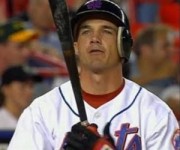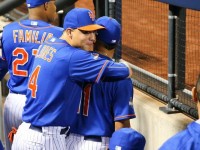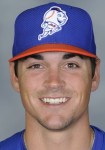Gavin Cecchini

Whenever a prospect is coming through the system or a young player makes his way to the majors, invariably there is a comparison made to an All Star caliber player. Very rarely do we see a comparison to a utility player or a grinder like Joe McEwing.
With that said, if Matt Reynolds wants to be a part of this Mets team going forward, he will need to become this generation’s Super Joe.
Right now, Reynolds path to the majors is blocked. At the major league level, the Mets have Asdrubal Cabrera, Ruben Tejada, and Wilmer Flores provide extraordinary major league depth at the shortstop position. On the horizon, the Mets have two very well regarded shortstop prospects in Gavin Cecchini and Amed Rosario. For what it’s worth, Rosario is likely ticketed to play shortstop in AA, and Cecchini will be the shortstop in AAA. In short (pun intended), Reynolds will never be the shortstop for the Mets.
Even if he moves off of shortstop, his options are limited. He’s blocked at second by Dilson Herrera. Even if the younger Herrera were to falter, it’s much more likely that the Mets would turn to Cecchini or sign a free agent than Reynolds. Also, given his lack of power throughout the minors, it’s unlikely the Mets will turn to him go play third. No, Reynolds’ future, at least with the Mets, is as a utility player.
For his part, Reynolds is willing to play all over the field just to make it to the majors. He will play some outfield during Spring Training. As Reynolds told Adam Rubin, he knows a position change is in order:
No one has talked to me about it, but I heard about it from press conferences and everything. I’m willing to do whatever it takes to make it to the big leagues. I figured that I’d probably be changing positions. Honestly, I just look at it as it makes me more versatile, and there’s more opportunity for me to get called up and maybe stay up there.
Now, Joe McEwing was only a 28th round pick. When you are a 28th round pick, you are not seen as a prospect. You have to be ready, willing, and able to do whatever is necessary to get to the majors. It’s not only a talent issue. It’s a mindset. You have to show a lot of character and resiliency not only to make it to the majors, but also to stay there.
It was McEwing’s attitude and drive that helped him have a nine year career. It’s why Tony LaRussa requested a pair of autographed spikes from McEwing. He has the type of energy and drive that is infectious. It’s why he was a useful player. It’s why teams loved having him on the roster. It’s why he stays in the game as a major league coach and is a potential manager.
Reynolds was a second round pick. Typically, second round picks are not seen as utility players. As long as they produce, they usually have an easier path to the majors. With that said, it’s no guarantee. At some point, every player faces a turning point in their careers. For Matt Reynolds, that time is now. It’s time for him to embrace his future as a utility player.
Seemingly, he’s doing that. If he meets this challenge with the same drive and enthusiasm that McEwing once did, Reynolds has a real future not just with the Mets, but in baseball. It’s quite possible Reynolds’ future with the Mets is this generation’s Joe McEwing. Right now, Reynolds seems ready to do what is necessary to get to that point.
If he does, that means Reynolds will have a fine major league career.

After the Mets make a decision at catcher, the team appears like they will have between $82 – $96 million to build a roster and re-sign their pitching.
Looking at the roster, the Mets will need to obtain starters at the following positions: 1B, 2B, SS, and RF. David Wright is scheduled to make $15 million, so whether or not you believe he will be able to stay at the position, he will remain with the team in some capacity. Michael Conforto should still be with the team as the leftfielder. Finally, unless the Mets can move him, Juan Lagares and his $9 million salary will be the team’s centerfielder. The Mets organization is fairly well stocked with position players right now, and they might be able to fill out the roster with cheap, cost-controlled talent.
First Base
Somewhat controversely, Keith Law named Dominic Smith the 29th best prospect in all of baseball. He’s the first baseman of the future.
Accordingly to the scouting reports, Smith is a good defensive first baseman that should be able to hit. The debate really is whether he will hit for power. Whether or not he hits for power, people see him as being able to field the position and be a good major league hitter.
With Lucas Duda being a free agent in 2018, the Mets will need Smith to be ready. If he’s not ready, the Mets will need a stopgap. In either event, by the time the Mets pitchers start to become free agents, Smith should be the first baseman earning around $500,000.
Second Base
We have to assume that one of these years Dilson Herrera is going to transition from second baseman of the future to the Mets second baseman. With Neil Walker only having one year until free agency, it appears that time will be 2017.
Right now, Herrera has less than one year’s service time. For all the supposed newfound depth, it’ll probably be Matt Reynolds getting called up to the Mets. That will preserve his service time. It means that in 2019, Herrera should be the second baseman, and he will have accrued two full years service time. Unless he gets enough playing time, it appears like he will avoid Super Two status meaning he will be in the same $500 – $600 thousand range as Smith.
Shortstop
As far as organizational depth, the Mets seemingly have an embarassment of riches with two high end shortstop prospects with Gavin Cecchini and Amed Rosario. They also have the aforementioned Reynolds.
Given Asdrubal Cabrera‘s contract, Cecchini and Rosario are going to have time to develop on the minors. At a minimum, Cabrera is signed to be the Mets shortstop through the 2017 season. If he produces well, or the prospects need another year, Cabrera has an option that could keep him with the Mets through the 2018 season.
As such, neither Cecchini or Rosario will be arbitration eligible at the time the Mets pitchers start to reach free agency. Accordingly, the Mets will only have to spend around $500 thousand when the pitchers begin to become free agents.
Left Field
It seems Michael Conforto is the leftfielder of the past (2015), present, and future. He very well should be too. Even if Conforto doesn’t improve upon his 162 game averages he achieved as a 22 year old, who never played above AA, you’re getting a good defensive outfielder who will hit .270/.335/.506 with 26 homers and 75 RBI.
Fortunately, Conforto will not have accrued enough service time to achieve Super Two status. Unfortunately, Conforto will most likely become arbitration eligible the same time that the Mets pitchers are reaching free agency.
Looking over the past few years, there isn’t really a good comparable to Conforto. It seems that when teams have good young corner outfielders, they lock them up. With that in mind, although an admittedly imperfect comparison, J.D. Martinez is instructive.
In 2014, Martinez was 26 years old, and he hit .325/.358/.553 with 23 homers and 76 RBI in 123 games. He became arbitration eligible after this season, and he agreed to $3 million. In 2015, he had another good year hitting .282/.344/.535 with 38 homeruns and 102 RBI. He and the Tigers avoided an arbitration hearing. Martinez’s contract extension bought out the remainder of his arbitration years he’s due to make $6.75 million in 2016 and $11.75 million in 2017.
While we may or may not agree on whether Martinez is a good comparable, it would be fair to say Conforto is at least capable of hitting .272/.344/.535 by his age 25 season, if not sooner. If that’s the case, it would be fair to suggest Conforto could earn anywhere from $3 – $6 million in his first year of eligibility.
Right Field
Curtis Granderson‘s contract will expire after the 2017 season. Since he will be 37 heading into the 2018 season, it’s hard to imagine he will be re-signed to be the everyday right fielder.
Now, Wuilmer Becerra projects to be an everyday player. Scouts believe he has the bat to play the corner outfield spot. The issue as far as the Mets are concerned is how quickly the 21 year old minor leaguer will need before fulfilling that promise. Last year, Becerra played his first year in full season A ball. That’s a long trek to the majors by 2019.
So unless Brandon Nimmo can handle the corner outfield offensively, which unfortunately seems unlikely, the Mets will have to look outside the organization to fill that void.
If Becerra is still a well regarded prospect, the Mets are likely to bring in a player on a one to two year deal. In retrospect, depending on how he finishes out his contract, Granderson could be coaxed back on a one-year deal ata much lower contract price.
As a placeholder, let’s presume the cost of a right fielder would cost about $15 million. That’s what Granderson is slated to earn the last year of his contract.
Cost of the Projected 2019 Starting Lineup
If everything breaks right for the Mets, they will have a group of young, cost-controlled position players at the time their starting pitchers hit the free agent market. If this pans out, the Mets everyday position players would cost about $46.5 million.
That’s roughly what the Mets are paying their current starting infield. In total, the 2016 Mets starting lineup is due to be paid roughly $90 million. Essentially, the Mets will be spending half the amount of money on their starting lineup in 2019 than they will this season.
Overall, this leaves the Mets between $35.5 – $49.5 million to build a bench, a bullpen, and to pay their starting rotation if the payroll remains stagnant at the $140 million range.

The recent Andrelton Simmons trade rumors suggests again the Mets know there is a hole at shortstop.
Last year, Wilmer Flores showed he wasn’t an everyday shortstop. On top of that with Daniel Murphy likely departing, he may be needed at second if Dilson Herrera isn’t ready. On top of that, Ruben Tejada once again exhibited limited range for the position, and that is before taking into account his broken leg. You’d like to say Matt Reynolds is an option, but he regressed at the plate last year in a hitter’s league and park. Furthermore, he, like Flores, is someone who may not profile as a major league shortstop.
The Mets have two well regarded shortstop prospects with Gavin Cecchini and Ahmed Rosario. Both played in AA for the first time last year. While Michael Conforto made the jump from AA to the majors, it would be unfair to presume these two could. Conforto did something rare. Accordingly, it’s safe to assume Cecchini and Rosario are at least two to three years away from playing with the big league club.
The free agent market is thin at shortstop with the best option being a high priced player in decline for the past two years. Furthermore, the Mets unloaded their best trade pieces on rentals to go all-in last year. This begs the question, what do you do?
Well, there’s only one thing to do. You let the free agent market shake out. You look to take on one of the remaining shortstops on either a minor league deal or a cheap major league deal. I’m sure a player like Jimmy Rollins is looking for one last chance to win a World Series. Alexei Ramirez may want a one year deal to re-establish his value.
No, I’m not excited about these players either. However, it’s the reality of the Mets situation. Much like they wanted to catch lightning in a bottle with Flores last year, they’re looking to do it again next year with Flores or whoever else it may be.
It’s difficult knowing the Mets real shortstops are two plus years away, but the team is ready to win now.

As of today, the Mets 40 man roster is full with Erik Goeddel and David Wright on the 60 day DL. Since players on the 60 day DL do not count towards the 40 man roster, two players will have to be removed from the 40 man before Goeddel and Wright can be added.
The first decision could potentially come on August 11th, when Goeddel is first eligible to come off the DL. The Mets can send down Hansel Robles, who has options, but that only solves the 25 man roster issue. As of today, here are the people who are on the 40 man roster, who are also not on the 25 man roster:
- Dario Alvarez
- Vic Black
- Jack Leathersich
- Steven Matz
- Akeel Morris
- Logan Verrett
- Gabriel Ynoa
- Johnny Monell
- Anthony Recker
- Dilson Herrera
- Danny Muno
- Wilfredo Tovar
- Darrell Ceciliani
- Michael Cuddyer
- Kirk Nieuwenhuis
In deciding who to remove, there are a couple of important factors to take into account:
- This player will be exposed on waivers allowing any team to claim that player, and
- A player must be on the 40 man roster as of August 31st to be eligible for the postseason roster (there are loopholes however).
Immediately, you can rule out the pitchers. They’re young, under control, and will be snatched up by another team . . . even Vic Black. That leaves eight players for two spots.
Next, we can eliminate Michael Cuddyer and Kirk Nieuwenhuis from consideration. Cuddyer is set to come off the DL soon. Nieuwenhuis is a possibility, albeit remote right now for the postseason roster. We’re done to six players.
I would next eliminate Dilson Herrera, who is seen as the second baseman of the future. This is especially important with Daniel Murphy, Kelly Johnson, and Juan Uribe set to be free agents. We’re down to five players: Monell, Recker, Muno, Tovar, and Ceciliani. Here’s where things get tricky. You can make cases for all of these players to stay or go.
I’ll start with the catchers, who have been awful this year . . . absolutely terrible. I’m expecting the Mets to move on from both of these players in the offseason. However, we need to remember Travis d’Arnaud has been injury prone. You don’t want to him to go down and have no playoff replacement. At a a minimum, one catcher must stay on the roster. Possibly both.
Up next are the young middle infielders. Admittedly, they have both been pretty bad in very limited major league experience. Accordingly, you can’t use that experience as the sole reason to outright that player. It should be noted neither player is a top prospect in the Mets organization. I think both are candidates, specifically Tovar, who is behind Matt Reynolds, Gavin Cecchini, and Amed Rosario on the organization’s SS depth chart.
Finally, we have Ceciliani, who played decently with the Mets this year (even if he was a little exposed). It should be noted he was passed over in the last two Rule Five Drafts. I don’t imagine his limited playing time changed the minds of the other 29 teams. Furthermore, with Nieuwenhuis being on the bubble for the postseason roster, there’s no chance he would even see the field. In my opinion, this makes him the most vulnerable.
Now, I have no connections whatsoever, but I would believe Ceciliani and Monell are the two players who will be moved to make room for Goeddel and Wright. You could easily interchange that for Recker and Ceciliani or one of the middle infielders. However, I think Ceciliani and Monell are the two least regarded players on this list.
Further complicating matters is Rafael Montero, who is also on the 60 day DL. Terry Collins recently went to talk to Montero to encourage him to ramp up his rehab so he can help the team. If Montero is coming back, the Mets are going to have to make yet another roster move. I believe at this time, the middle infielders would definitively be in danger of being removed from the 40 man roster. My guess would be Tovar, but then again, I could be wrong.
The only way to avoid removing anyone, and risking losing a player, is to make a trade with another team. The problem there is if these players had value to other teams, they would have been moved already. Specifically to Ceciliani, we’ve seen teams pass on him a number of times. There is also the possibility that the player to be named later in the Eric O’Flaherty deal is one of the aforementioned 15 players making part of this post moot. However, I think that is unlikely.
Overall, the Mets have a lot of important decisions to make with an eye towards who they want on the postseason roster. It’s fun to be a Mets fan again.

The Mets offense is officially offensive. As I tweeted last night, their runs per game is as follows:
April 4.35 runs per game
May 3.54 runs per game
June 2.96 runs per game
July 2.87 runs per game.
This is unsustainable and had led to a -16 run differential. Things need to be fixed quickly to reverse these trends or the Mets run the risk of letting the season get away. For the purposes of this post, I’ll take the front office at face value and assume a trade can’t be competed just yet. Also, I’m not going to waste my breath here about bringing Conforto up to the majors (that’s for another time). The front office has made it clear he’s not getting called up. However, that does not mean something can’t be done now.
First: Transfer Wright to the 60 day disabled list. He’s been gone for 60 days already. Not putting him on the 60 day DL is roster mismanagement. Once Wright is put on the 60 day DL, the Mets can call up someone not in the 40 man roster.
Second: Call up Matt Reynolds (he’s not on the 40 man roster) and install him as the everyday SS. Let’s face it – since the day the Mets refused to resign Reyes, Tejada had been given several chances to become the everyday SS and failed. In this latest attempt, he had a triple slash line of .255/.322/.360 and a UZR of 0.8, i.e. he is bad at the plate and average in the field. CORRECTION: after posting this I learned Matt Reynolds is on the 7 day DL.
Reynolds had a triple slash line of .270/.327/.410. I wasn’t able to find his UZR information, but scouts seem optimistic on his defense. If Reynolds minor league stats carry over, the Mets improve the SS position and the bench. If they don’t translate (the PCL is a hitter’s league after all), he had a cup of coffee. It’s not like his production would be so bad as to justify carrying Eric Campbell on the roster (side note: I’m sorry because Campbell works hard and really tries to help the team). I know Reynolds isn’t on the 40 man roster, but so what? Are you really afraid of losing
Third: Outright Alex Torres and recall Logan Verrett. This would leave the Mets with only one lefty in the pen, Sean Gilmartin, who is not a LOOGY. However, Torres isn’t effective against lefties. Lately, he hadn’t been effective at all. In a small sample size, Verrett has been largely effective for the Mets.
Fourth: Recall Dilson Herrera, bench Wilmer Flores, and release John Mayberry, Jr. In his last 10 games, Herrera is hitting .359 with a .390 OBP. He’s hot. Flores has been bad defensively and at the plate. However, he does have some pop in his bat and could be an effective PH. To make room for Herrera, Mayberry should be released. He just hasn’t hit. He’s taking up a valuable roster spot right now.
Fifth: Call up Travis Taijeron and send down Danny Muno. I know I joked yesterday about Taijeron and the Mets need for more minor leaguers. However, this post is seeking drastic measures to help this team, which is best done by eliminating most of the bench. This season Taijeron’s triple slash is an eye opening .271/.395/.523. Why hasn’t he been called up? Well he is not a highly thought of prospect having been drafted in the 11th round in 2011. Why send down Muno? He’s bad at baseball. Travis Taijeron is not in the 40 man roster, but I am comfortable exposing Wilfredo Tovar to waivers.
With all the machinations, the Mets have mostly retooled their bench (except Nieuwenhuis and Recker) and they find out what they have in Reynolds and Taijeron. Also, it creates a spot for with Nimmo or Conforto in AAA and possibly Gavin Cecchini as well. Maybe I’m wrong, but at least this is something.